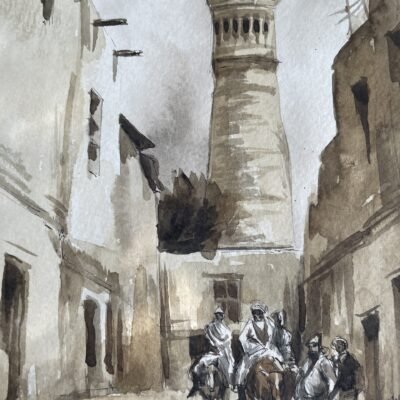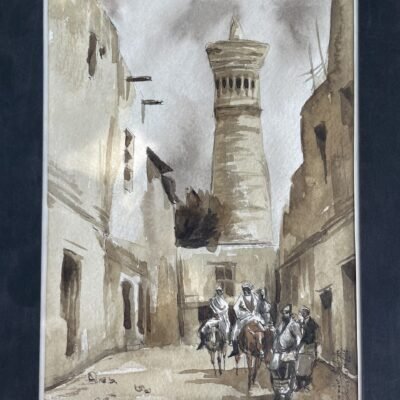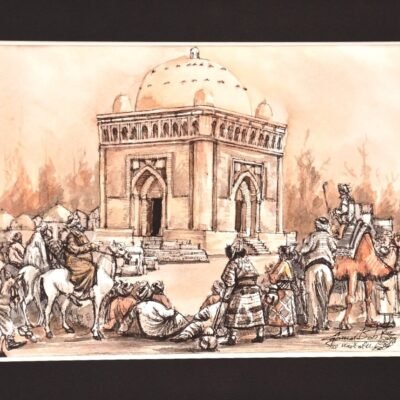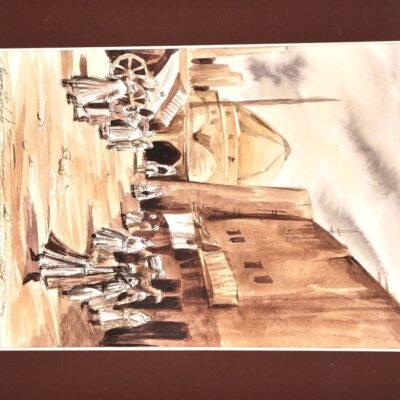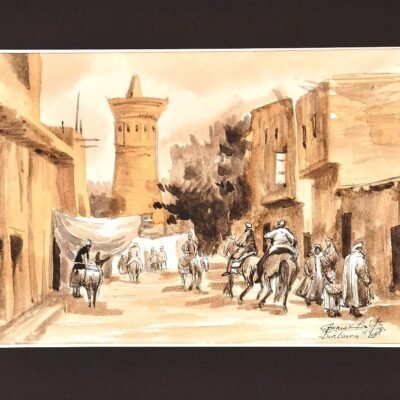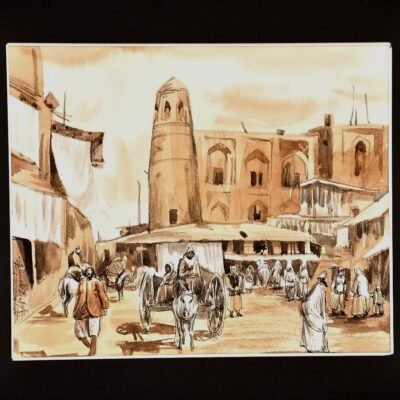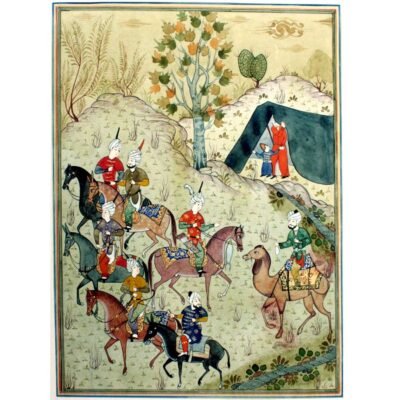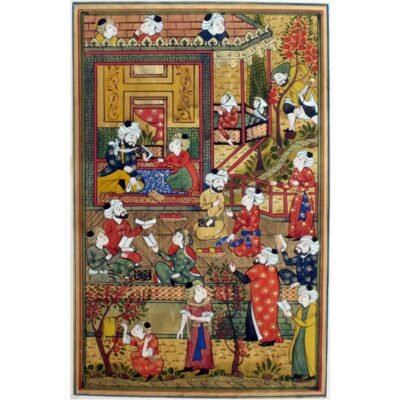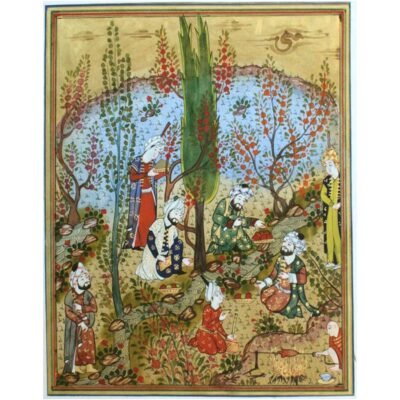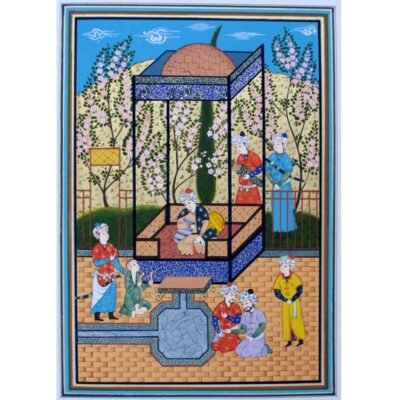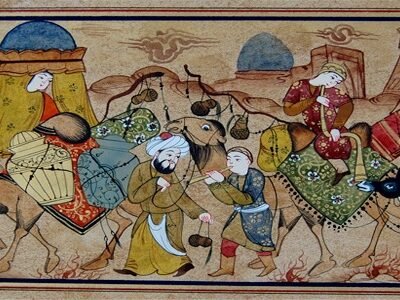The Flourishing of Miniature Paintings in Persia
One of the most renowned traditions of miniature painting emerged in Persia (modern-day Iran) during the 13th century. Persian miniatures were characterized by their delicate brushwork, intricate patterns, and harmonious color schemes. They depicted a wide range of subjects, including courtly life, epic stories, and mystical landscapes. Persian miniature paintings reached their pinnacle during the Safavid dynasty (1501-1736), with artists like Kamal ud-Din Behzad and Reza Abbasi leaving an indelible mark on the art form.
The Colonial Legacy and Influence on Miniature Paintings
The arrival of European colonial powers in the Indian subcontinent had a significant impact on miniature painting traditions. European artists and collectors were fascinated by the miniatures they encountered and began to influence the style and subject matter of Indian miniature paintings. The Mughal Empire, known for its opulent courts, saw the fusion of Persian and Indian artistic traditions, resulting in a unique style of miniature painting.
The Revival of Miniature Paintings in Contemporary Art
In recent decades, miniature paintings have experienced a revival in both the East and the West. Contemporary artists, such as Shahzia Sikander, have reimagined the genre, pushing the boundaries of traditional techniques and themes. Sikander's neo-miniatures explore issues of identity, gender, and cultural hybridity, while still paying homage to the rich tradition of miniature painting.
The Characteristics of Miniature Paintings
Intricate Detailing and Precision
One of the defining features of miniature paintings is their intricate detailing and precision. Artists use fine brushes and magnifying lenses to create intricate patterns, delicate facial expressions, and minute details, often requiring immense patience and skill. The level of detail in these miniatures allows viewers to immerse themselves in the artwork, discovering new elements with each observation.
Rich Color Palette
Miniature paintings are known for their rich and vibrant color palette. Artists utilize natural pigments sourced from minerals, plants, and insects, as well as gold leaf to add a touch of opulence. These colors not only serve a decorative purpose but also convey symbolic meanings and evoke emotions within the viewer.
Symbolism and Narrative
Miniature paintings are filled with symbolism and tell intricate stories. Each element, from the placement of figures to the choice of colors, carries meaning and contributes to the overall narrative. These visual narratives often draw from religious, mythological, and historical sources, offering a glimpse into the cultural and social context of the time.
Miniature Paintings as Visual Poetry
Miniature paintings are often compared to visual poetry due to their ability to convey complex emotions and ideas in a small space. Like a poem, a miniature painting can evoke a profound emotional response through its composition, colors, and subject matter. It invites viewers to pause, reflect, and immerse themselves in a world of beauty and contemplation.
The Techniques and Materials Used in Miniature Paintings
Traditional Techniques Passed Down Through Generations
The creation of miniature paintings requires meticulous craftsmanship and adherence to traditional techniques. Artists learn these techniques through years of apprenticeship under experienced masters, passing down the knowledge from one generation to another. The mastery of techniques such as fine brushwork, layering of colors, and intricate detailing is essential to create authentic miniature paintings.
The Use of Natural Pigments and Gold Leaf
Traditional miniature paintings utilize natural pigments derived from minerals, plants, and insects. These pigments, such as lapis lazuli for blue, vermilion for red, and saffron for yellow, create a vibrant and rich color palette. Gold leaf is often used to add a touch of opulence and highlight specific elements of the artwork, such as jewelry or architectural details.
Contemporary Approaches and Experimentation
While traditional techniques form the foundation of miniature painting, contemporary artists have also embraced experimentation and innovation. They incorporate new materials, mix traditional and modern techniques, and explore unconventional subjects and styles. This blending of tradition and contemporary approaches has brought fresh perspectives to the art form, allowing for its continued evolution and relevance.
The Themes and Subjects in Miniature Paintings
Religious and Mythological Stories
Miniature paintings have long been used to depict religious and mythological stories. In Persian and Mughal traditions, miniatures often depicted scenes from the Quran, the epics of Shahnameh and Mahabharata, and tales of gods and goddesses. These paintings served as visual aids for storytelling and religious instruction, inviting viewers to connect with the spiritual and mythical realms.
Portraits and Courtly Life
The courts of Persia, India, and other regions were patrons of miniature paintings, commissioning portraits of rulers, nobles, and courtiers. These portraits captured the opulence, grandeur, and intricacies of courtly life. The artists' attention to detail and ability to convey the essence of their subjects made these portraits highly prized.
Nature and Landscapes
Nature and landscapes are popular themes in miniature paintings. Artists meticulously depict flora, fauna, and scenic vistas, often imbuing them with symbolic meanings. These miniature landscapes offer glimpses into idyllic and imagined worlds, inviting viewers to immerse themselves in the beauty of nature.
Social and Political Commentary
Miniature paintings have also been used as a means of social and political commentary. Artists, particularly during times of political upheaval, used their work to express dissent, critique societal norms, and document historical events. These miniatures serve as important historical artifacts, providing insights into the social and political climate of their time.
The Masters of Miniature Paintings
Persian Miniature Painting: A Legacy of Elegance
Persian miniature painting has produced numerous master artists whose works continue to inspire and captivate audiences. Kamal ud-Din Behzad, a prominent Persian miniaturist, is revered for his delicate brushwork and ability to capture human emotions. Reza Abbasi, another celebrated artist, excelled in portraiture and created delicate and expressive miniature paintings.
Indian Miniature Painting: A Harmonious Blend of Cultures
Indian miniature painting also boasts a rich lineage of master artists. Basawan, a Mughal court artist, introduced Persian techniques into Indian miniature painting, enriching the style with his unique vision. In the Rajput courts, artists like Nihal Chand and Sahibdin pioneered the use of vibrant colors and intricate detailing, creating exquisite miniatures that reflect the cultural diversity of India.
Mughal Miniature Painting: Grandeur and Opulence
The Mughal Empire in India witnessed the golden age of miniature painting. Artists like Abd al-Samad and Ustad Mansur were renowned for their ability to capture the grandeur and opulence of the Mughal courts. The Mughal miniatures blend Persian and Indian artistic traditions, resulting in a distinctive style that continues to influence contemporary artists.
Contemporary Artists Pushing Boundaries
Contemporary artists, such as Shahzia Sikander, have reinvigorated the art of miniature painting. Sikander, known for her neo-miniatures, combines traditional techniques with a contemporary aesthetic, exploring themes of identity, gender, and cultural hybridity. Her innovative approach has garnered international acclaim and has inspired a new generation of miniature artists.
Collecting Miniature Paintings: A Timeless Treasure
Authenticity and Provenance
When collecting miniature paintings, authenticity and provenance are of utmost importance. It is essential to ensure that the artwork is created using traditional techniques and materials. Collectors should seek out reputable galleries, auction houses, and artists who can provide detailed information about the artwork's origins and a clear chain of ownership.
Preservation and Care
Proper preservation and care are crucial to maintain the longevity of miniature paintings. These delicate artworks should be protected from direct sunlight, extreme temperatures, and excessive humidity. Framing the artwork with archival materials and using UV-protective glass can help prevent damage and fading.
Displaying and Enjoying Miniature Paintings
Miniature paintings deserve to be displayed and enjoyed. They can be showcased individually or as part of a curated collection. Their small size allows for versatile display options, such as wall-mounted frames, tabletop easels, or even in decorative boxes. Rotating the display periodically prevents prolonged exposure to light and ensures that all pieces in the collection receive equal attention.
Miniature Paintings For Sale
Auctions and Galleries
Auctions and galleries play a significant role in the sale and promotion of miniature paintings. Specialized art auctions often feature rare and exceptional pieces, attracting collectors and connoisseurs. Galleries dedicated to miniature art offer curated exhibitions and provide a platform for artists to showcase their work, connecting them with potential buyers and enthusiasts.
The Online Marketplace
The emergence of online platforms has made miniature paintings more accessible to a global audience. For example, collectors can browse through Alesouk’s vast selection of artworks, connect with artists and dealers, and make purchases from the comfort of their homes. However, it is important to exercise caution and research the credibility of sellers before making any online transactions.
The Future of Miniature Paintings
Miniature Paintings as Cultural Heritage
Miniature paintings hold immense cultural and historical significance and are considered valuable cultural heritage. Efforts are being made to preserve and promote this art form, ensuring its continuity for future generations. Museums, cultural institutions, and educational programs play a vital role in safeguarding and promoting miniature painting traditions.
The Influence of Technology on Miniature Art
Technology has opened up new possibilities for miniature artists. Digital tools and platforms have allowed artists to experiment with techniques and reach a wider audience. Artists can now connect with collectors, art enthusiasts, and fellow artists from around the world, fostering a global community that transcends geographical boundaries.
Conclusion
Miniature paintings, with their timeless allure and intricate beauty, continue to captivate art lovers around the world. Rooted in a rich history and tradition, miniature paintings offer a unique glimpse into the cultural, social, and historical aspects of the regions they originate from. As contemporary artists push the boundaries of the art form, miniature paintings remain a cherished and evolving art form, bridging the gap between tradition and innovation. Collecting and appreciating miniature paintings is not only a testament to their artistic merit but also a celebration of the human capacity for creativity and storytelling.



